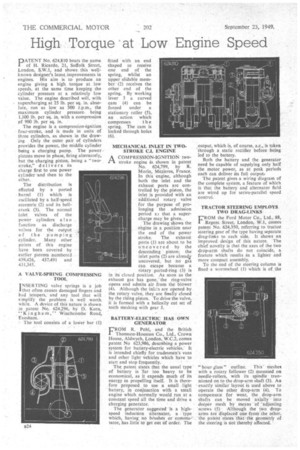High Torque at Low Engine Speed
Page 58

If you've noticed an error in this article please click here to report it so we can fix it.
PATENT No. 624,810 bears the name of H. Ricardo, 21, Suffolk Street, London, S.W.1, and shows this wellknown designer's latest improvements in engines. His aim is to produce an engine giving a high torque at low speeds, at the same time keeping the cylinder pressure at a relatively low value. The engine described will, with supercharging at 25 lb. per sq. in. absolute, run as low as 500 r.P.m., the maximum cylinder pressure, being 1,100 lb. per sq. in. with a compression of 900 lb. per sq. in.
The engine is a compression-ignition four-stroke, and is made in units of three cylinders, as shown in the drawing Only the outer pair of cylinders provides the power, the middle cylinder being a charging pump. The power pistons move in phase, firing alternately, but the charging piston, being a " twostroke," delivers its charge first to one power cylinder and then to the other.
The distribution is effected by a ported barrel (1) which is oscillated by a half-speed eccentric (2) and its bellcrank (3). The normal inlet valves of the power cylinders a 1 so function as discharge valves for the output of the pumping cylinder. Many other points of this engine have been covered by earlier Patents numbered 439,426, 457,491 and 431,345.
A VALVE-SPRING. COMPRESSING TOOL INSERTING valve springs is a job that often causes damaged fingers and bad temper's, and any tool that will simplify the problem is 'well worth while, A device of this nature is shown in patent No. 624,296,; by D. Keen,
ingh aria,'' -Winchcombe Road,
Evesham. • • The tool consists of a lower bar (1)
fitted with an end shaped to receive one end of the spring, whilst an upper sIidable member (2) receives the other end of the spring. By working lever 3 a curved cam (4) can be forced under a stationary roller (5), an action which compresses the spring. The cam is locked through holes (6).
MECHANICAL INLET IN TWOSTROKE CI ENGINE Jk COMPRESSION-IGNITION twofn stroke engine is shown in patent No. 624,799, by R. Morin, Mezieres, France. In this engine, although both the inlet and the exhaust ports are controlled by the piston, the inlet is provided with an additional rotary valve for the purpose of prolonging the admission period so that a supercharge may be given..
The drawing shows the engine in a position near the end of the power stroke. The exhaust ports (1) are about to be uncovered by the descending piston; the inlet ports (2)•are already uncovered, but no gas can escape because a rotary ported-ring .(3) is in its dosed position. As soon as the exhaust gas has gone, the ring-valve opens and admits air from the blower (4). Although the inlets are opened by the rotary valve, they are finally closed by the rising piston. To drive the Valve, it is formed with a helically cut set of teeth meshing with gear 5.
BATTERY-ELECTRIC HAS OWN GENERATOR
FROM R. Pohl, and the British Thomson-Houston Co., Ltd., Crown House, Aldwych, London, W.C.2, comes patent No 623,986, describing a power system for battery-electric vehicles. It is intended chiefly for tradesmen's vans and other light vehicles which have to start and stop frequently.
The patent states that the usual type of battery is tar too heavy to be economical, as it expends much of its energy in propelling itself. It is therefore proposed to use a small light battery, in conjunction with a small engine which normally would run at a constant speed all the time and drive a charging generator. •
The generator suggested is a highspeed induction alternator, a type which, having no brushes or' comrnu-tator, has little to get out of order. The
,.output, which is, of course, ac., is taken through a static rectifier before being led to the battery.
Both the battery and the generator need be capable of supplying only half the motor power, as at peak periods each can deliver its full output: The patent gives a wiring diagram of the complete system, a feature of which is that the battery and alternator field are wired up for series-parallel speed control.'
TRACTOR STEERING EMPLOYS TWO DRAG-LINKS
FROM the Ford Motor Co., Ltd., 88, Regent Street, London, W.1, comes patent No. 624,350, referring to tractor steering gear of the type having separate drag-links to 'each side. It shows an improved design of this nature. The chief novelty is that the axes of the two dronsarm shafts do not coincide, a. feature which results in a lighter and more compact assembly.
To the end of the steering column is fixed a wormwheel (I) 'which is of the " hour glass " outline. This meshes
with a rotary follower (2) mounted on needle-rollers, with its spindle trunnioned on to the drop-arm shaft (3). An exactly similar layout is used above to operate the other drop-arm (4). To compensate for wear, the drop-arm shafts can be moved axially into deeper mesh by means 'of :adjusting screws (5) Although the two droparms are displaced 'one -from the other, -the patent -states tbatethe ieornctey of the steering is not thereby affected.




























































































